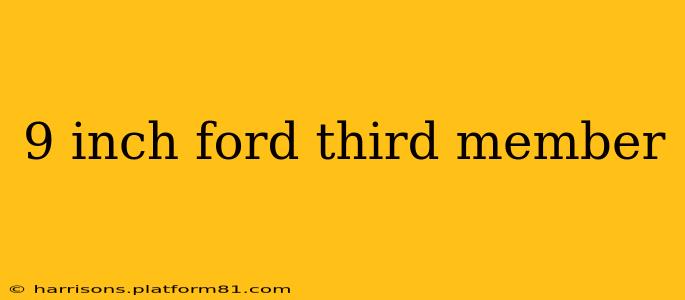The Ford 9-inch differential, often referred to as the 9-inch third member, is legendary among hot rodders, off-road enthusiasts, and performance car builders. Its robust design, readily available parts, and incredible strength make it a popular choice for a wide range of applications. This guide will delve into the intricacies of this iconic component, addressing common questions and providing valuable information for both novices and experienced mechanics.
What is a Ford 9-Inch Third Member?
The "third member" is simply another term for the differential assembly. In the context of the Ford 9-inch, it refers to the entire housing containing the ring and pinion gears, axles, and differential carrier. This robust unit is responsible for transferring power from the driveshaft to the rear wheels, allowing them to rotate at different speeds during turns. The 9-inch's popularity stems from its exceptionally strong construction, capable of handling significant horsepower and torque. This makes it ideal for high-performance vehicles and those subjected to extreme conditions.
What are the Different Types of Ford 9-Inch Third Members?
Ford produced the 9-inch differential across several decades and for various applications, resulting in several variations. These differences often lie in the casing's construction, the type of axle shafts, and the gear ratios available. Some key distinctions include:
- Housing Material: Early versions used cast iron, while later models incorporated nodular iron for increased strength. Some aftermarket housings are even constructed from stronger materials like aluminum or chromoly steel.
- Axle Shaft Style: Different axle shaft configurations exist, ranging from simpler designs to those incorporating stronger, larger-diameter shafts with integral c-clips.
- Gear Ratios: Numerous gear ratios were offered throughout the 9-inch's production run, catering to a wide range of performance and application needs. From low-gear ratios for towing or off-roading to higher ratios for improved top speed, the variety is extensive.
What Makes the Ford 9-Inch Third Member So Popular?
The enduring popularity of the Ford 9-inch stems from several key factors:
- Strength and Durability: Its robust design can handle immense power and torque, making it a reliable choice for high-performance vehicles.
- Part Availability: A vast aftermarket parts network ensures readily available components for upgrades, repairs, and modifications.
- Customization Options: The 9-inch offers incredible flexibility in terms of customization, allowing for gear ratio changes, upgraded axles, and various other modifications.
- Adaptability: The 9-inch can be adapted to fit a broad range of vehicles, making it a versatile option for custom builds.
How Much Does a Ford 9-Inch Third Member Cost?
The cost of a Ford 9-inch third member varies greatly depending on several factors:
- Condition: A used, rebuilt unit will be significantly cheaper than a new, professionally built assembly.
- Modifications: The presence of upgrades, such as high-performance axles or custom gear ratios, will dramatically impact the price.
- Source: Purchasing from a salvage yard will typically be cheaper than buying from a specialist performance parts supplier.
Expect to find used units for several hundred dollars, while fully built, high-performance assemblies can cost several thousand.
What are the Common Problems with Ford 9-Inch Third Members?
While exceptionally durable, even a Ford 9-inch can experience issues:
- Bearing Wear: Regular inspection and maintenance are crucial to prevent bearing wear, which can lead to catastrophic failure.
- Seal Leaks: Leaks around the axle seals or the differential cover can necessitate repairs.
- Gear Wear: Excessive wear on the ring and pinion gears can affect performance and necessitate replacement.
How Do I Identify My Ford 9-Inch Third Member?
Identifying a 9-inch third member involves checking for several key features:
- Housing Dimensions: The housing itself is a significant indicator; it’s wider and taller than most other differentials.
- Axle Tube Diameter: The 9-inch has a large axle tube diameter.
- Cover Bolts: The number and pattern of the cover bolts are distinctive.
If you're unsure, consulting resources specific to Ford differential identification or seeking the advice of a specialist is recommended.
This guide provides a comprehensive overview of the Ford 9-inch third member. Remember to always consult a qualified mechanic for any complex repairs or modifications. The information provided here is for educational purposes and shouldn't be taken as professional advice.
